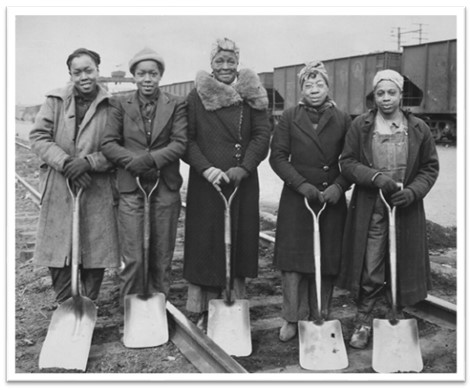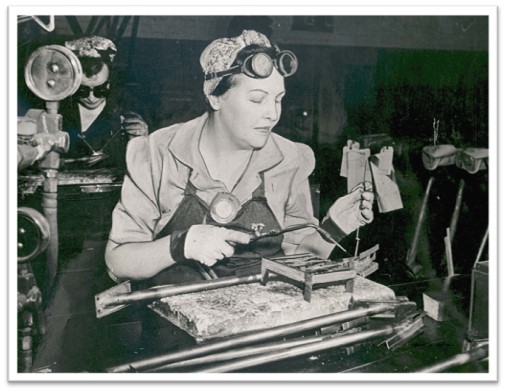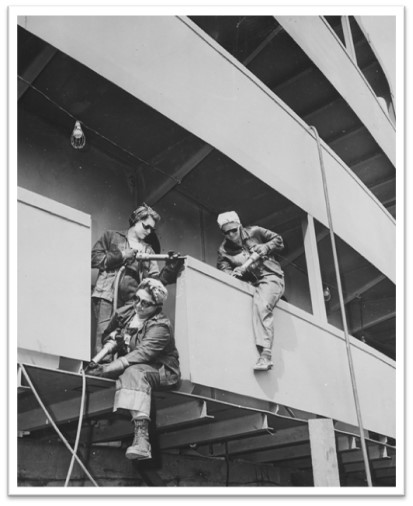
With a large group of men off to war during WWII, women were joining the workforce to aid in the war effort. The typical role of the American woman up to this point was to be married, have children and be a homemaker while her husband was at work. Though not all women followed this path, it was the expectation.
When World War II pulled men from their jobs and to the war front, women were the ones who filled their shoes. This was uncharted territory for women. They had the opportunity to “do their part” for the war effort, and they now had a sense of freedom. They were making their own money and using that money on whatever they decided. Women worked alongside each other regardless of race and age too, social standards set aside to focus on a common goal.
We have learned much about women’s fashion during World War II. Clothing was rationed and mandated to help provide more metals and fabric for the war effort. Silhouettes were trim and fitted to the body with little volume or excess fabric. The war changed women’s fashion in other ways, too. Let’s talk about the modern, patriotic woman in the workforce during the war and what she would have worn.
Looking at the working woman’s fashion standards, they seemed quite eloquent for blue collar work. These standards were an extension of femininity, regardless of getting sweaty and dirty in laborious factories. For a not so glamourous job, women in the workforce were expected and encouraged to look their best while working as a way to boost morale. As Gabriela Hernandez writes in her book, Classic Beauty: The History of Makeup. “[t]he use of bright red lipstick had such an impact on morale for women during World War II that it has become forever linked to improving confidence and as a symbol of victory,” (119). Along with having to wear red lipstick for the sake of symbolic duty and patriotism.
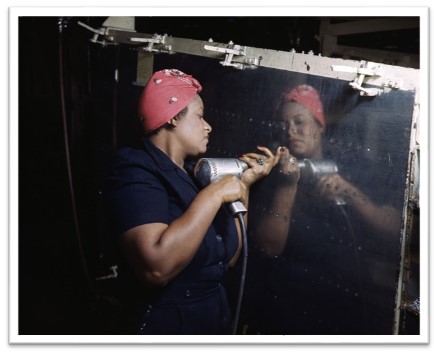
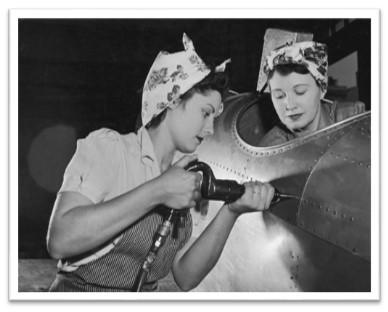
Hair accessories and soft curls aided with the feminine appearance for these working women. Not only did head scarves and turbans provide safety measures for the workplace, but they also were trendy and added a unique style to each woman’s drab overalls and jumpsuits. Typically, a scarf or turban would keep hair from falling in a worker’s face, and it allowed for styled curls at the front to peek out to show softness and femininity. As we can see in the picture to the left, these workers are both wearing floral headscarves which are both fashionable and functional as they work. Though the image is black and white, we can see the deep red lipstick they both sport.
Women in the factories wore a range of clothing that was appropriate for the job at hand. Jumpsuits, overalls and the like were all about function. Plain in design and color, these garments typically were collared and buttoned, providing a utilitarian style that dominated women’s fashion overall. Pants were full in the leg, and depending on the worker’s job, wore boots or flat shoes. Like the woman in the picture on the right, we can see her wearing a hair turban, short- sleeved shirt tucked into her pants. The full-legged trousers were the trend, however; they were also perfect for comfort and ease on the job. Though there were safety precautions taken in the 1940s, one might wonder if those pant legs could have gotten caught in some type of machinery.
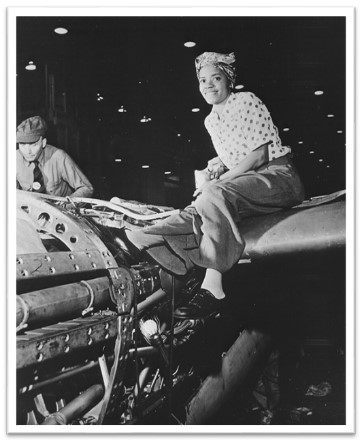
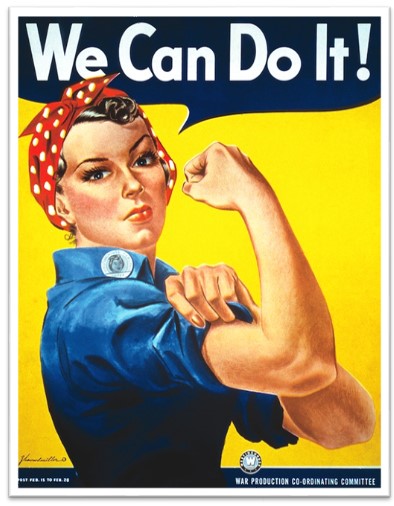
A well-known icon in pop culture today is Rosie the Riveter. Though there are a few versions of this character, the picture to the left is arguably the most recognized. We see Rosie the Riveter rolling up her sleeves and flexing her bicep as she does. She wears a jumpsuit or button-down shirt, looking at her viewer with a toughened stare, all while embodying feminine style. Her hair is curled and pulled back under a turban. We can see by her ensemble that she is working in a factory of some sort, yet she sports red lips, mascara, and red nails; she was the epitome of what a working woman was supposed to look like. The slogan in the word bubble, “We Can Do It!” is an emboldening slogan to encourage women to join the war effort, whether it be the Women’s Army Corp (WAC) or working the railroads to ensure smooth travels of supplies. The picture below highlights a group of African American women who worked on the railroad tracks for the Baltimore & Ohio Railroad Company circa 1943. They are dressed appropriately for the weather with long coats, overalls, and gloves. A few of these workers are wearing hair turbans which as discussed were fashionable, but also would have kept their heads warm.
Women joining the workforce during World War II played a crucial part in the victory of the Allies. As Stephen Ambrose writes in his book, D-Day “The contribution of the women of America, whether on the farm or in the factory or in uniform, to D-Day was a sine qua non of the invasion effort.” So, it is not a stretch to say that the course of the war may have been different if the women on the American Homefront had not stepped up to the plate in so many crucial ways.
While women took on new roles in the work force, their fashion played its role along with them. It boosted morale and provided a degree of personal style. During World War II, as with other periods in history, fashion is more than just items we wear for the sake of function; they also provide confidence, joy, and originality. Through fashion, there is a sense of comradery in times where society and the world need it most.
